The Identification and Diagnosis of ‘Hidden Ice’ in the Mountain Domain
Abstract
1. Introduction
2. Glacier Mapping
A glacier or perennial snow mass, identified by a single GLIMS glacier ID, consists of a body of ice and snow that is observed at the end of the melt season, or, in the case of tropical glaciers, after transient snow melts. This includes, at a minimum, all tributaries and connected feeders that contribute ice to the main glacier, plus all debriscovered parts of it. Excluded is all exposed ground, including nunataks. An ice shelf … shall be considered as a separate glacier.([12], p. 4)
3. Debris-Covered Glaciers and Rock Glaciers
A glacier-shaped mass of angular rock either with interstitial ice, firn and snow or covering the remnants of a glacier, moving slowly downslope. If in doubt about the ice content, the frequently present surface firn fields should be classified as ‘Glacieret and snowfield’.
- They are found in mountainous regions that have, or have had, glacial/’periglacial’ conditions.
- They have the outward appearance of being composed of rock debris.
- They show the extent of this rock debris as distinct limits, both marginally and terminally (but less distinctly at their heads).
- They have a debris source area (or areas), i.e., a head and, in addition, a distinct snout, which marks their maximum extent down-slope.
- They have, in many cases, flow-like features on their surfaces. The rock glacier is supposed to flow (or have) flowed, in the case of relict features, as a result of ice contained in some manner within the rock debris.
4. Rock Glacier Definitions
‘Rock glaciers are characteristic landforms associated with mountain periglacial landscapes. They are prevalent periglacial items of the Earth’s geomorphological heritage, whose identification (detection and delineation) can be nevertheless challenging’.([25], p. 4)
‘Rock glaciers are identified and mapped as functional or inherited (relict) landforms of the geomorphological landscape: they are part of the mountain sediment cascade and as such contribute to control the pace of periglacial mountain landscape evolution’([25], p. 5)
5. Survey and Mapping Methods and the Need for a ‘Ground Truth’
The post-glacial dynamics of these systems and their associated landforms comprise spatio-temporally complex and interlaced glacial, periglacial, paraglacial, hydrological, and mass-wasting processes, whose full understanding requires high-resolution, quantitative, multi-method, and interdisciplinary approaches.
6. Epidemiology of Glacier Ice Cores in Rock Glaciers
6.1. Glaciers with Thin Debris Covers
6.2. Classic Rock Glaciers in the Wrangell Mountains, Alaska
6.3. Stranded Glacier Ice and Rock Glaciers
6.4. Classic Sites: Galena Creek RG and Gruben RG
6.5. Ice Exposure at and near Cirque Headwalls
6.6. Surface Meltwater Pool in Large Rock Glacier Systems
6.7. Rock Glaciers in Volcanic Areas
7. Discussion
8. Conclusions
- Rock glaciers may show ice exposures below surface debris from top to snout; these exposures are related to massive ice of glacier origin.
- A continuum of glacier ice exists from high elevation to low elevation. It is along this profile that glacier ice exposure and surface meltwater pools can most easily be found and monitored.
- Rock debris accumulates on glacier surfaces to insulate the ice below, the melting of which may be of the order of many tens of years depending upon the local climate.
- Whether a glacier GL, a glacier with debris load GLd, or a rock glacier RG form depends upon the (perhaps changing) mass balances of the two components.
- No evidence of massive interstitial ice accumulation at the base of scree slopes (talus) can be recognised.
- Rock glaciers provide a store of ice protected by the super-incumbent debris; this ice may descend to much lower altitudes than if it were not so protected.
- The distinction between a glacier with debris cover and a rock glacier may not be distinct, but mapping RG as part of the extant ice body (hidden ice) of an area is permissible.
- Google Earth can provide a valuable way to identify glacier and RG limits, as well as the presence of ice exposures.
- Ice exposures should be mapped and recorded, as in an epidemic, to evaluate climate change effects in the cryosphere.
- The presence of rock glaciers does not indicate mountain permafrost, and they should not be used for mapping permafrost.
- The definition and usage of rock glaciers as being permafrost indicators by RGIK and as essential climatic variables should be deprecated.
Funding
Institutional Review Board Statement
Informed Consent Statement
Data Availability Statement
Acknowledgments
Conflicts of Interest
References
- Orlove, B.S.; Wiegandt, E.; Luckman, B.H. Darkening Peaks: Glacier Retreat, Science, and Society; University of California Press: London, UK, 2008. [Google Scholar]
- Cecil, L.D.; Green, J.R.; Thompson, L.G. (Eds.) Earth Paleoenvironments: Records Preserved in Mid- and Low-Latitude Glaciers; Kluwer: Dordrecht, The Netherlands, 2004. [Google Scholar]
- Zemp, M.; Frey, H.; Gärtner-Roer, I.; Nussbaumer, S.U.; Hoelzle, M.; Paul, F.; Haeberli, W.; Denzinger, F.; Ahstrøm, A.P.; Anderson, B. Historically unprecedented global glacier decline in the early 21st century. J. Glaciol. 2015, 61, 745–762. [Google Scholar] [CrossRef]
- Grove, J.M. The Little Ice Age, Ancient and Modern; Routledge: London, UK, 2004; Volume 2. [Google Scholar]
- Oerlemans, J. (Ed.) Glacier Fluctuations and Climate Change; Kluwer: Dordrecht, The Netherlands, 1989. [Google Scholar]
- Hattersley-Smith, G. The symposium on glacier mapping. Can. J. Earth Sci. 1966, 3, 737–741. [Google Scholar] [CrossRef]
- Röthlisberger, H. Introduction. Ann. Glaciol. 1986, 8, 1. [Google Scholar] [CrossRef]
- Kasser, P.; Röthlisberger, H. Some problems of glacier mapping experienced with the 1: 10000 map of the Aletsch Glacier. Can. J. Earth Sci. 1966, 3, 799–809. [Google Scholar] [CrossRef]
- Pelto, M.S.; Pelto, J. The Loss of Ice Worm Glacier, North Cascade Range, Washington USA. Water 2025, 17, 432. [Google Scholar] [CrossRef]
- Raup, B.; Racoviteanu, A.; Khalsa, S.J.S.; Helm, C.; Armstrong, R.; Arnaud, Y. The GLIMS geospatial glacier database: A new tool for studying glacier change. Glob. Planet. Change 2006, 56, 101–110. [Google Scholar] [CrossRef]
- RGI Consortium. Randolph Glacier Inventory—A Dataset of Global Glacier Outlines: Version 6.0: Technical Report, Global Land Ice Measurements from Space; NSIDC: Boulder, CO, USA, 2017. [Google Scholar]
- Raup, B.; Khalsa, S.J.S. GLIMS Analysis Tutorial; National Snow and Ice Data Center: Boulder, CO, USA, 2010. [Google Scholar]
- Millar, C.I.; Westfall, R.D. Rock glaciers and related periglacial landforms in the Sierra Nevada, CA, USA; inventory, distribution and climatic relationships. Quat. Int. 2008, 188, 90–104. [Google Scholar] [CrossRef]
- Whalley, W.B. Mapping small glaciers, rock glaciers and related features in an age of retreating glaciers: Using decimal latitude-longitude locations and ‘geomorphic information tensors’. Geogr. Fis. Din. Quat. 2021, 44, 55–67. [Google Scholar]
- Whalley, W.B. Geomorphological information mapping of debris-covered ice landforms using Google Earth: An example from the Pico de Posets, Spanish Pyrenees. Geomorphology 2021, 393, 107948. [Google Scholar] [CrossRef]
- Whalley, W.B.; Martin, H.E.; Gellatly, A.F. The problem of “hidden” ice in glacier mapping. Ann. Glaciol. 1986, 8, 181–183. [Google Scholar] [CrossRef]
- Corte, A.E. Glaciers and glaciolithic systems of the Central Andes 1980. In World Glacier Inventory: Proceedings of the Workshop at Riederalp, Switzerland, 17–22 September 1978; International Association of Hydrological Sciences: Wallingford, UK, 1980; pp. 11–24. [Google Scholar]
- Müller, F.; Caflisch, T.; Müller, G. Instructions for Compilation and Assemblage of Data for a World Glacier Inventory; Department of Geography, Swiss Federal Institute of Technology (ETH) Zürich: Zürich, Switzerland, 1977. [Google Scholar]
- Whalley, W.B.; Martin, H.E. Rock glaciers: II models and mechanisms. Prog. Phys. Geogr. 1992, 16, 127–186. [Google Scholar] [CrossRef]
- Herreid, S.; Pellicciotti, F. What can thermal imagery about glacier melt below rock debris. Frontiers 2020, 13, 621–627. [Google Scholar] [CrossRef]
- Harrison, S.; Jones, D.B.; Racoviteanu, A.E.; Anderson, K.; Shannon, S.; Betts, R.A.; Leng, R. Rock glacier distribution across the Himalaya. Glob. Planet. Change 2024, 239, 104481. [Google Scholar] [CrossRef]
- Knight, J.; Harrison, S.; Jones, D.B. Rock glaciers and the geomorphological evolution of deglacierizing mountains. Geomorphology 2019, 324, 14–24. [Google Scholar] [CrossRef]
- Jones, D.B.; Harrison, S.; Anderson, K.; Shannon, S.; Betts, R.A. Rock glaciers represent hidden water stores in the Himalaya. Sci. Total Environ. 2021, 793, 145368. [Google Scholar] [CrossRef] [PubMed]
- Jones, D.B.; Harrison, S.; Anderson, K.; Whalley, W.B. Rock glaciers and mountain hydrology: A review. Earth Sci. Rev. 2019, 193, 66–90. [Google Scholar] [CrossRef]
- RGIK. IPA Action Group Rock Glacier Inventories and Kinematics. Towards Standard Guidelines for Inventorying Rock Glaciers: Baseline Concepts (Version 4.2.2); RGIK: Fribourg, Switzerland, 2022; Available online: https://www.unifr.ch/geo/geomorphology/en/research/ipa-action-group-rock-glacier/ (accessed on 8 July 2025).
- Seppi, R.; Carton, A.; Zumiani, M.; Dall’Amico, M.; Zampedri, G.; Rigon, R. Inventory, distribution and topographic features of rock glaciers in the southern region of the Eastern Italian Alps (Trentino). Geogr. Fis. Din. Quat. 2012, 35, 185–197. [Google Scholar] [CrossRef]
- Bhat, I.A.; Rashid, R.; Ramsankaran, R.A.A.J.; Banerjee, A.; Vijay, S. A comprehensive rock glacier inventory for Jammu, Kashmir, and Ladakh, western Himalaya, India–Baseline for the permafrost research. Earth Syst. Sci. Data Discuss. 2024, 2024, 1–25. [Google Scholar] [CrossRef]
- Thiessen, R.; Bonnaventure, P.P.; Lapalme, C.M. Rock glacier inventory and predictive modeling in the Mackenzie Mountains: Predicting rock glacier likelihood with a generalized additive model. Arct. Sci. 2024, 10, 653–672. [Google Scholar] [CrossRef]
- Onaca, A.; Ardelean, F.; Urdea, P.; Magori, B. Southern Carpathian rock glaciers: Inventory, distribution and environmental controlling factors. Geomorphology 2017, 293, 391–404. [Google Scholar] [CrossRef]
- Abdullah, T.; Romshoo, S.A. A Comprehensive Inventory, Characterization, and Analysis of Rock Glaciers in the Jhelum Basin, Kashmir Himalaya, Using High-Resolution Google Earth Data. Water 2024, 16, 2327. [Google Scholar] [CrossRef]
- Mergili, M.; Kopf, C.; Müllebner, B.; Schneider, J.F. Changes of the cryosphere and related geohazards in the high-mountain areas of Tajikistan and Austria: A comparison. Geogr. Ann. Ser. A Phys. Geogr. 2012, 94, 79–96. [Google Scholar] [CrossRef]
- Hassan, J.; Chen, X.; Muhammad, S.; Bazai, N.A. Rock glacier inventory, permafrost probability distribution modeling and associated hazards in the Hunza River Basin, Western Karakoram, Pakistan. Sci. Total Environ. 2021, 782, 146833. [Google Scholar] [CrossRef]
- Martin, H.E.; Whalley, W.B. Rock glaciers: Part 1: Rock glacier morphology: Classification and distribution. Prog. Phys. Geogr. 1987, 11, 260–282. [Google Scholar] [CrossRef]
- Feynman, R. What is science? Resonance 2011, 16, 860–873. [Google Scholar] [CrossRef]
- Whalley, W.B. The geolocation of features on information surfaces and the use of the open and FAIR data principles in the mountain landscape domain and geoheritage. Permafr. Periglac. Process. 2024, 35, 98–108. [Google Scholar] [CrossRef]
- Barsch, D. Rockglaciers. In Advances in Periglacial Geomorphology; Clark, M.J., Ed.; Wiley: Chichester, UK, 1988; pp. 69–90. [Google Scholar]
- Clark, D.H.; Clark, M.M.; Gillespie, A.R. Debris-covered glaciers in the Sierra Nevada, California, and their implications for snowline reconstructions. Quat. Res. 1994, 41, 139–153. [Google Scholar] [CrossRef]
- Corte, A.E. Rock glacier taxonomy. In Rock Glaciers; Giardino, J.F., Jr., Shroder, J.F., Jr., Vitek, J.D., Eds.; Allen and Unwin: London, UK, 1987; pp. 27–39. [Google Scholar]
- Deluigi, N.; Lambiel, C. PERMAL: A Machine Learning Approach for Alpine Permafrost Distribution Modeling. Jahrestagung der Schweiz. Geomorph. Ges. 2013. Available online: https://www.researchgate.net/publication/267393953_PERMAL_a_machine_learning_approach_for_alpine_permafrost_distribution_modeling (accessed on 9 July 2025).
- Domaradzki, J. Blockströme in Kanton Graubunden. Ergebnisse Wissenschaftlichen Untersuchungen im Schweiz. National- park 1951, 3, 177–235. Available online: https://www.parcs.ch/snp/pdf_public/1588_domaradzki_blockstroeme_nf_1951.pdf (accessed on 7 July 2025).
- Evin, M. Lithology and fracturing control of rock glacier in southwestern Alps of France and Italy. In Rock Glaciers; Giardino, J.F., Jr., Shroder, J.F., Jr., Vitek, J.D., Eds.; Allen and Unwin: London, UK, 1987; pp. 83–106. [Google Scholar]
- Giardino, J.R.; Vitek, J.D. The significance of rock glaciers in the glacial-periglacial landscape continuum. J. Quat. Sci. 1988, 3, 97–103. [Google Scholar] [CrossRef]
- Ikeda, A.; Matsuoka, N. Pebbly versus bouldery rock glaciers: Morphology, structure and processes. Geomorphology 2006, 73, 279–296. [Google Scholar] [CrossRef]
- Johnson, P.G. Mass movement of ablation complexes and their relationship to rock glaciers. Geogr. Ann. A. 1974, 56, 93–101. [Google Scholar] [CrossRef]
- Johnson, P.G. Rock Glacier: Glacier Debris Systems or High-Magnitude Low-Frequency Flows. In Rock Glaciers; Giardino, J.F., Jr., Shroder, J.F., Jr., Vitek, J.D., Eds.; Allen and Unwin: London, UK; pp. 175–192.
- Jones, D.B.; Harrison, S.; Anderson, K. Mountain glacier-to-rock glacier transition. Global Plan. Change 2019, 181, 102999. [Google Scholar] [CrossRef]
- Leigh, J.; Evans, D.; Stokes, C.; Andreassen, L.; Carr, R. Glacial and periglacial geomorphology of central Troms and Finnmark county, Arctic Norway. J. Maps 2021, 17, 348–366. [Google Scholar] [CrossRef]
- Lindner, L.; Marks, L. Types of debris slope accumulations and rock glaciers in South Spitsbergen. Boreas 1985, 14, 139–153. [Google Scholar] [CrossRef]
- Østrem, G. Rock glaciers and ice-cored moraines, a reply to D. Barsch. Geogr. Ann. A. 1971, 53, 207–213. [Google Scholar] [CrossRef]
- Outcalt, S.I.; Benedict, J.B. Photo-interpretation of two types of rock glacier in the Colorado Front Range, USA. J. Glaciol. 1965, 5, 849–856. [Google Scholar] [CrossRef]
- Potter, J.N.; Steig, E.; Clark, D.; Speece, M.; Clark, G.T.; Updike, A.B. Galena Creek rock glacier revisited—New observations on an old controversy. Geogr. Ann. Ser. A Phys. Geogr. 1998, 80, 251–265. [Google Scholar] [CrossRef]
- Potter, N. Ice-cored rock glacier, Galena Creek, northern Absaroka Mountains, Wyoming. Geol. Soc. Am. Bull. 1972, 83, 3025–3058. [Google Scholar] [CrossRef]
- RGIK. IPA Action Group Rock Glacier Inventories and Kinematics. Rock Glacier Velocity as an associated parameter of ECV Perma-frost: Baseline Concepts (Version 3.2). Report. 2023. Available online: https://bigweb.unifr.ch/Science/Geosciences/Geomorphology/Pub/Website/IPA/CurrentVersion/Current_RockGlacierVelocity.pdf (accessed on 9 July 2025).
- Wahrhaftig, C.; Cox, A. Rock glaciers in the Alaska Range. Geol. Soc. Am. Bull. 1959, 70, 383–436. [Google Scholar] [CrossRef]
- Wilson, P. Relict rock glaciers, slope failure deposits, or polygenetic features? A reassessment of some Donegal debris landforms. Ir. Geogr. 2004, 37, 77–87. [Google Scholar] [CrossRef]
- Whalley, W.B. Remote Sensing and Landsystems in the Mountain Domain: FAIR Data Accessibility and Landform Identification in the Digital Earth. Remote Sens. 2024, 16, 3348. [Google Scholar] [CrossRef]
- Berthling, I. Beyond confusion: Rock glaciers as cryo-conditioned landforms. Geomorphology 2011, 131, 98–106. [Google Scholar] [CrossRef]
- Haeberli, W. Modern research perspectives relating to permafrost creep and rock glaciers: A discussion. Permafr. Periglac. Process. 2000, 11, 290–293. [Google Scholar] [CrossRef]
- Barsch, D. Rockglaciers. In Indicators for the Present and Former Geoecology in High Mountain Environments; Springer: Berlin, Germany, 1996; 331p. [Google Scholar] [CrossRef]
- Hu, Z.; Yan, D.; Feng, M.; Xu, J.; Liang, S.; Sheng, Y. Enhancing mountainous permafrost mapping by leveraging a rock glacier inventory in northeastern Tibetan Plateau. Int. J. Digit. Earth 2024, 17, 2304077. [Google Scholar] [CrossRef]
- Janke, J.; Regmi, N.; Giardino, J.; Vitek, J. 8.17 Rock Glaciers. Treatise on Geomorphology; Academic Press: San Diego, CA, USA, 2013; Volume 8, pp. 238–273. [Google Scholar]
- Lilleøren, K.S.; Etzelmüller, B.; Rouyet, L.; Eiken, T.; Hilbich, C. Transitional rock glaciers at sea-level in Northern Norway. Earth Surf. Dyn. Discuss. 2022, 10, 975–996. [Google Scholar] [CrossRef]
- Kääb, A.; Røste, J. Rock glaciers across the United States predominantly accelerate coincident with rise in air temperatures. Nat. Commun. 2024, 15, 7581. [Google Scholar] [CrossRef]
- Hu, Y.; Arenson, L.U.; Barboux, C.; Bodin, X.; Cicoira, A.; Delaloye, R.; Gärner-Rose, I.; Kääb, A.; Kellerer-Pirklbauer, A.; Lambiel, C.; et al. Rock glacier velocity: An essential climate variable quantity for permafrost. Rev. Geophys. 2025, 63, e2024RG000847. [Google Scholar] [CrossRef]
- Meng, T.; Tober, B.S.; Aguilar, R.J.; Daniel, M.F.; Jacobo-Bojórquez, R.A.; Nerozzi, S.; Holt, J.B. Effects of rock glacier dynamics on surface morphology and deformation. J. Geophys. Res. Earth Surf. 2025, 130, e2024JF008106. [Google Scholar] [CrossRef]
- Clark, D.H.; Steig, E.J.; Potter, N., Jr.; Gillespie, A.R. Genetic variability of rock glaciers. Geogr. Ann. Ser. A Phys. Geogr. 1998, 80, 175–182. [Google Scholar] [CrossRef]
- Whalley, W.B.; Palmer, C.F. A glacial interpretation for the origin and formation of the Marinet Rock Glacier, Alpes Maritimes, France. Geogr. Ann. Ser. A Phys. Geogr. 1998, 80, 221–236. [Google Scholar] [CrossRef]
- Konrad, S.K.; Humphrey, N.F.; Steig, E.J.; Clark, D.H.; Potter, N., Jr.; Pfeffer, W.T. Rock glacier dynamics and paleoclimatic implications. Geology 1999, 27, 1131–1134. [Google Scholar] [CrossRef]
- Whalley, W.B.; Marangunic, C. Landscapes and Landsystems: Rock glaciers in the mountain slope domain of South America. J. S. Am. Earth Sci. 2025. [Google Scholar]
- Wee, J.; Vivero, S.; Mathys, T.; Mollaret, C.; Hauk, C.; Lambiel, C.; Beutel, J.; Haeberli, W. Characterizing ground ice content and origin to better understand the seasonal surface dynamics of the Gruben rock glacier and the adjacent Gruben debris-covered glacier (southern Swiss Alps). Cryosphere 2024, 18, 5939–5963. [Google Scholar] [CrossRef]
- Heng, A.H.S.; Chew, F.T. Systematic review of the epidemiology of acne vulgaris. Sci. Rep. 2020, 10, 5754. [Google Scholar] [CrossRef]
- Whalley, W.B. An exposure of ice on the distal side of a lateral moraine. J. Glaciol. 1973, 12, 327–329. [Google Scholar] [CrossRef]
- Whalley, W.B.; Palmer, C.F.; Hamilton, S.J.; Kitchin, D. Supraglacial debris-transport variability over time: Examples from Switzerland and Iceland. Ann. Glaciol. 1996, 22, 181–186. [Google Scholar] [CrossRef][Green Version]
- Capps, S.R. Rock glaciers in Alaska. J. Geol. 1910, 18, 359–375. [Google Scholar] [CrossRef]
- Azizi, F.; Whalley, W.B. Numerical modelling of the creep behaviour of ice-debris mixtures under variable thermal regimes. In Proceedings of the Sixth International Offshore and Polar Engineering Conference, Los Angeles, CL, USA, 26–31 May 1996; International Society of Offshore and Polar Engineers: Mountain View, CA, USA, 1996. [Google Scholar]
- Whalley, W.B.; Azizi, F. Rheological models of active rock glaciers: Evaluation, critique and a possible test. Permafr. Periglac. Process. 1994, 5, 37–51. [Google Scholar] [CrossRef]
- Whalley, W.B.; Azizi, F. Rock glaciers and protalus landforms: Analogous forms and ice sources on Earth and Mars. J. Geophys. Res. Planets 2003, 108, 8032. [Google Scholar] [CrossRef]
- Whalley, W.B. Glacier–rock glacier interactions in the eastern Hindu Kush, Nuristan, Afghanistan [35.92,71.13] in the period 1976–2019. Geogr. Ann. A 2024, 105, 91–120. [Google Scholar] [CrossRef]
- Whalley, W.B. A rock glacier and its relation to the mass balance of corrie glaciers, Strupbreen, Troms, Norway. Nor. Geogr. Tidsskr. 1976, 30, 52–55. [Google Scholar]
- Humlum, O.; Christiansen, H.H.; Juliussen, H. Avalanche-derived rock glaciers in Svalbard. Permafr. Periglac. Process. 2007, 18, 75–88. [Google Scholar] [CrossRef]
- Messerli, B.; Zurbuchen, M. Blockgletscher im Weissmies und Aletsch und ihre photogrammetrische Kartierung. Die Alp. 1968, 44, 139–152. [Google Scholar]
- Haeberli, W. Creep of Mountain Permafrost: Internal structure and flow of alpine rock glaciers. Mitteilungend der Vers. für Wasserbau Hydrol. und Glaziologie 1985, 77, 142. [Google Scholar]
- Whalley, W.B. Enhancing the Digital Earth via digital decimal geolocation and the FAIR data principles. Earth Sci. Syst. Soc. 2024, 4, 10110. [Google Scholar] [CrossRef]
- Whalley, W.B. The Glacier—Rock Glacier Mountain Landsystem: An example from North Iceland. Geogr. Ann. Ser. A Phys. Geogr. 2021, 103, 346–367. [Google Scholar] [CrossRef]
- Anderson, L.W.; Anderson, D.S. Weathering rinds on quartzarenite clasts as a relative-age indicator and the glacial chronology of Mount Timpanogos, Wasatch Range, Utah. Arct. Alp. Res. 1981, 13, 25–31. [Google Scholar] [CrossRef]
- SummitPost.org. 100 Years on the Timanogos Glacier. Available online: https://www.summitpost.org/page/186144 (accessed on 7 July 2005).
- Hotaling, S.; Morriss, M. Mountain rock glaciers: An overlooked, climate resilient water source for Utah? In Proceedings of the 17th Annual Salt Lake County Watershed Symposium, West Valley, CL, USA, 15–16 November 2023; Available online: https://www.youtube.com/watch?v=YhFZmVFKrgQ (accessed on 7 July 2005).
- Reheis, M.J. Source, transportation and deposition of debris on Arapaho Glacier, Front Range, Colorado, USA. J. Glaciol. 1975, 14, 407–420. [Google Scholar] [CrossRef]
- Gabrielli, S.; Spagnolo, M.; De Siena, L. Geomorphology and surface geology of Mount St. Helens volcano. J. Maps 2020, 16, 585–594. [Google Scholar] [CrossRef]
- Deline, P.; Hewitt, K.; Reznichenko, N.; Shugar, D. Rock avalanches onto glaciers. In Landslide Hazards, Risks, and Disasters; Elsevier: Amsterdam, The Netherlands, 2022; pp. 269–333. [Google Scholar]
- Bull, C.; Marangunic, C. The earthquake-induced slide on the Sherman Glacier, south-central Alaska, and its glaciological effects. Phys. Snow Ice Proc. 1967, 1, 395–408. [Google Scholar]
- Uhlmann, M.; Korup, O.; Huggel, C.; Fischer, L.; Kargel, J.S. Supra-glacial deposition and flux of catastrophic rock–slope failure debris, south-central Alaska. Earth Surf. Process. Landf. 2013, 38, 675–682. [Google Scholar] [CrossRef]
- Jiskoot, H. Long-runout rockslide on glacier at Tsar Mountain, Canadian Rocky Mountains: Potential triggers, seismic and glaciological implications. Earth Surf. Process. Landf. 2011, 36, 203–216. [Google Scholar] [CrossRef]
- Hotaling, S.; Becker, K.; Morriss, M. Rock Glaciers in Utah (Fact Sheet); Utah State University Extension: Logan, UT, USA, 2024; Available online: https://digitalcommons.usu.edu/extension_curall/2417/ (accessed on 7 July 2005).
- Chaix, A. Les coulées de blocs du Parc national suisse. Nouvelles mesures et comparaison avec les «rock stream» de la Sierra Nevada de Californie. Le Globe. Rev. Genevoise Géographie 1943, 82, 121–128. [Google Scholar] [CrossRef]
- Kesseli, J.E. Rock streams in the Sierra Nevada, California. Geogr. Rev. 1941, 31, 203–227. [Google Scholar] [CrossRef]
- Guyton, B. Glaciers of California: Modern Glaciers, Ice Age Glaciers, the Origin of Yosemite Valley, and a Glacier Tour in the Sierra Nevada; Univ of California Press: Auckland, CL, USA, 1998; Volume 59. [Google Scholar]
- Çalişkan, O.; Gürgen, G.; Yilmaz, E.; Yeşilyurt, S. Debris-Covered Glaciers in Aladağlar Mountains (Turkey). Trans. Jpn. Geomorphol. Union 2011, 32, 121–128. [Google Scholar]
- Miles, K.E.; Hubbard, B.; Irvine-Fynn, T.; Miles, E.S.; Quincey, D.J.; Rowan, A.V. Hydrology of debris-covered glaciers in High Mountain Asia. Earth Sci. Rev. 2020, 207, 103212. [Google Scholar] [CrossRef]
- Azócar, G.; Brenning, A. Hydrological and geomorphological significance of rock glaciers in the dry Andes, Chile (27–33°S). Permafr. Periglac. Process. 2010, 21, 42–53. [Google Scholar] [CrossRef]
- Angillieri, M.Y.E. Permafrost distribution map of San Juan Dry Andes (Argentina) based on rock glacier sites. J. S. Am. Earth Sci. 2017, 73, 42–49. [Google Scholar] [CrossRef]
- Whalley, W.B. Comment on “Ice content and interannual water storage changes of an active rock glacier in the dry Andes of Argentina” by Halla et al. (2021). Cryosphere 2023, 17, 699–700. [Google Scholar] [CrossRef]
- Blöthe, J.H.; Halla, C.; Schwalbe, E.; Bottegal, E.; Trombotto Liaudat, D.; Schrott, L. Surface velocity fields of active rock glaciers and ice-debris complexes in the Central Andes of Argentina. Earth Surf. Process. Landf. 2020, 46, 504–522. [Google Scholar] [CrossRef]
- Monnier, S.; Kinnard, C. Pluri-decadal (1955–2014) evolution of glacier–rock glacier transitional landforms in the central Andes of Chile (30–33° S). Earth Surf. Dyn. 2017, 5, 493–509. [Google Scholar] [CrossRef]
- Tielidze, L.G.; Cicoira, A.; Nosenko, G.A.; Eaves, S.R. The First Rock Glacier Inventory for the Greater Caucasus. Geosciences 2023, 13, 117. [Google Scholar] [CrossRef]
- Moussavi, M.; Valadan Zoej, M.J.; Vaziri, F.; Sahebi, M.R.; Rezaei, Y. A new glacier inventory of Iran. Ann. Glaciol. 2009, 50, 93–103. [Google Scholar] [CrossRef]
- Schweizer, G. Klimatisch bedingte geomorphologische und glaziologische Züge der Hochregion vorderasiatischer Gebirge (Iran und Ostanatolien). In Landschaftökologie der Hochgebirge Eurasiens; Franz Steiner Verlag GMBH: Stuttgart, Germany, 1972; pp. 221–236. [Google Scholar]
- Ferrigno, J.G. Glaciers of Iran Ferrigino G31–47, Satellite Image Atlas of Glaciers of the World. In Glaciers of the Middle East and Africa; Williams, R.S., Ed.; US Government Printing Office: Washington, DC, USA, 1991; p. 70. [Google Scholar]
- Foody, G.M. Ground Truth in Classification Accuracy Assessment: Myth and Reality. Geomatics 2024, 4, 81–90. [Google Scholar] [CrossRef]
- Østrem, G. Ice-cored moraines in Scandinavia. Geogr. Ann. Ser. A Phys. Geogr. 1971, 46, 282–337. [Google Scholar]
- Østrem, G. The transient snowline and glacier mass balance in southern British Columbia and Alberta, Canada. Geogr. Ann. Ser. A Phys. Geogr. 1964, 55, 93–106. [Google Scholar] [CrossRef]
- Barsch, D. Rock glaciers and ice-cored moraines. Geogr. Ann. Ser. A Phys. Geogr. 1971, 53, 203–206. [Google Scholar] [CrossRef]
- Troll, C. High mountain belts between the polar caps and the equator: Their definition and lower limit. Arct. Alp. Res. 1973, 5 (Suppl. 3), A19–A27. [Google Scholar] [CrossRef]
- Peltier, L.C. The geographic cycle in periglacial regions as it is related to climatic geomorphology. Ann. Assoc. Am. Geogr. 1950, 40, 214–236. [Google Scholar] [CrossRef]
- Haefeli, R.; Brentani, F. Observations in a cold ice cap. J. Glaciol. 1955, 2, 571–582. [Google Scholar] [CrossRef]
- Kunz, J.; Kneisel, C. Glacier–permafrost interaction at a thrust moraine complex in the glacier forefield Muragl, Swiss Alps. Geosciences 2020, 10, 205. [Google Scholar] [CrossRef]
- Kääb, A.; Kneisel, C. Permafrost creep within a recently deglaciated glacier forefield: Muragl, Swiss Alps. Permafr. Periglac. Process. 2006, 17, 79–85. [Google Scholar] [CrossRef]
- Jouvet, G.; Picasso, M.; Rappaz, J.; Blatter, H. A new algorithm to simulate the dynamics of a glacier: Theory and applications. J. Glaciol. 2008, 54, 801–811. [Google Scholar] [CrossRef]
- Swisstopo. Map Viewer. 2025. Available online: https://www.swisstopo.admin.ch/en/map-viewer-mapgeoadminch (accessed on 12 June 2025).
- Whalley, W.B. Gruben glacier and rock glacier, Wallis, Switzerland: Glacier ice exposures and their interpretation. Geogr. Ann. Ser. A Phys. Geogr. 2020, 102, 141–161. [Google Scholar] [CrossRef]
- Haeberli, W.; Arenson, L.U.; Wee, J.; Hauck, C.; Mölg, N. Discriminating viscous-creep features (rock glaciers) in mountain permafrost from debris-covered glaciers–a commented test at the Gruben and Yerba Loca sites, Swiss Alps and Chilean Andes. Cryosphere 2024, 18, 1669–1683. [Google Scholar] [CrossRef]
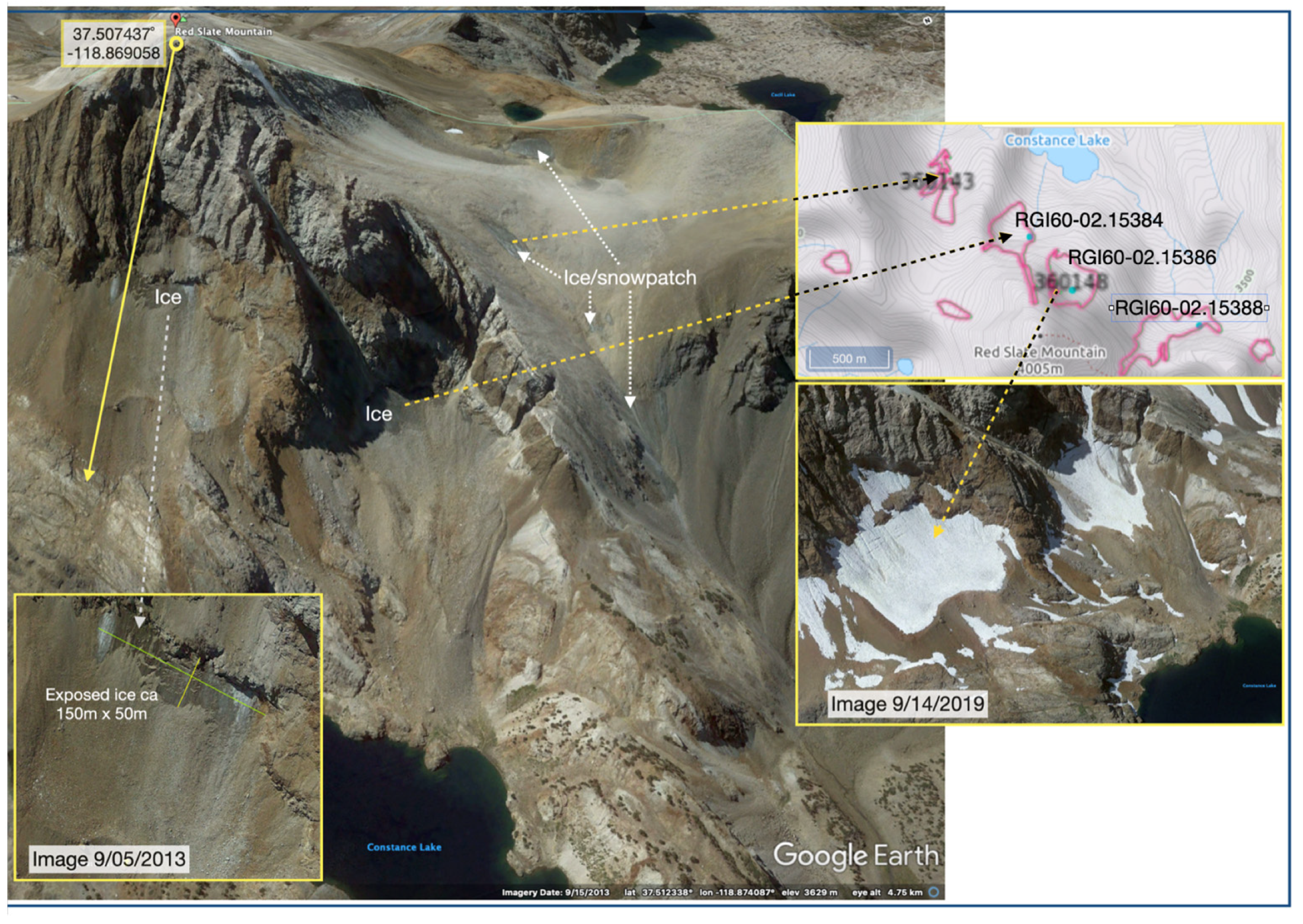
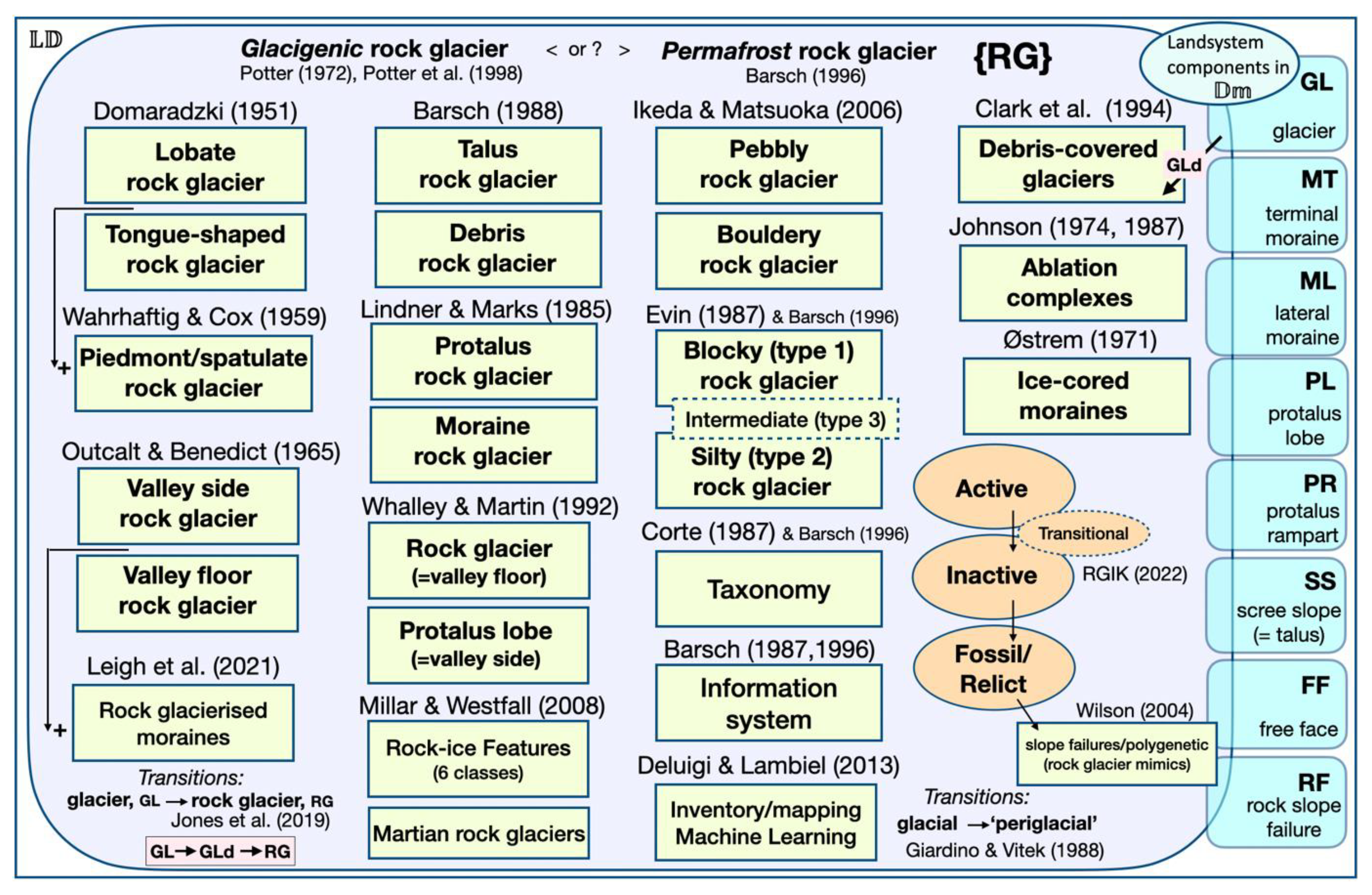
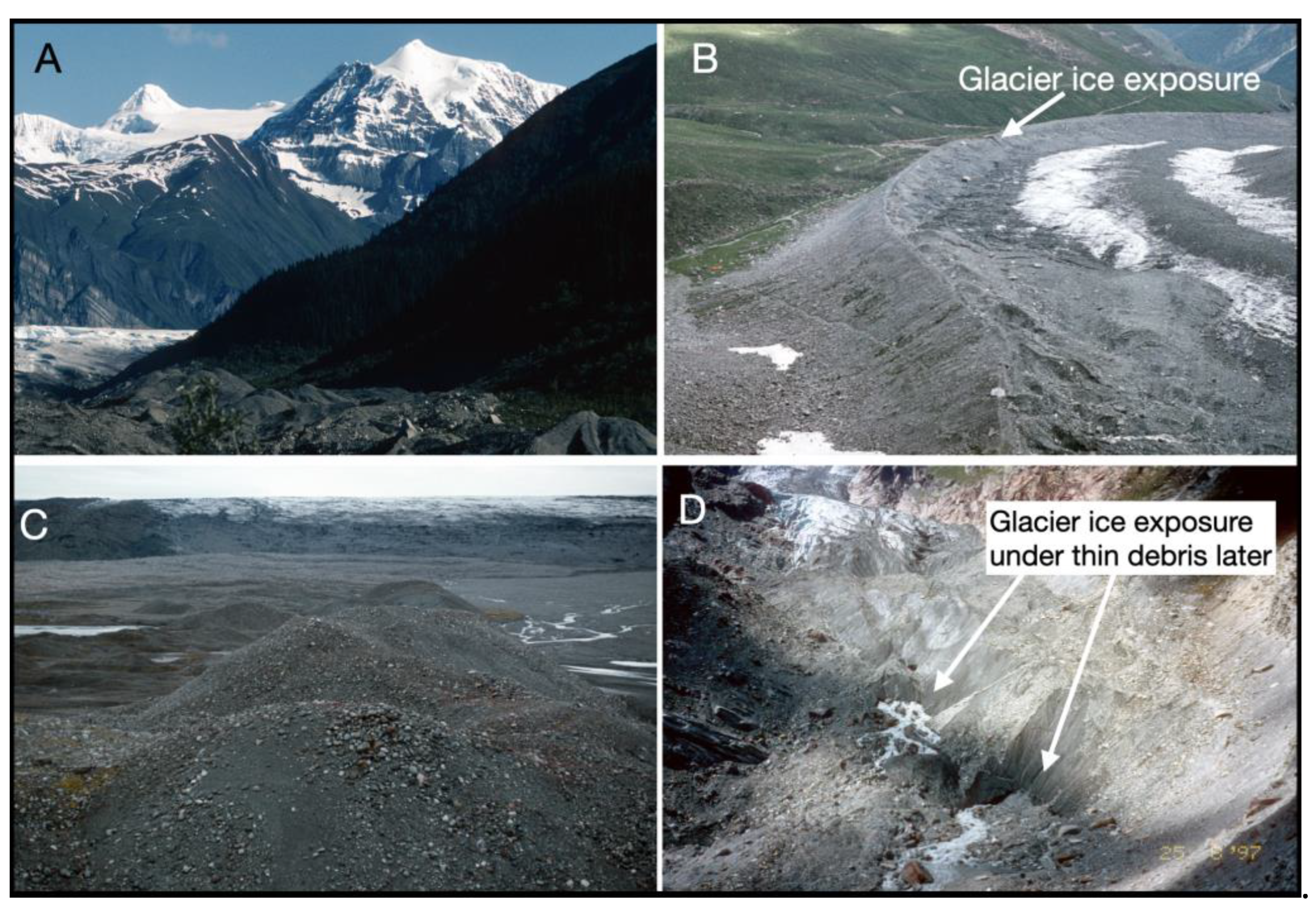
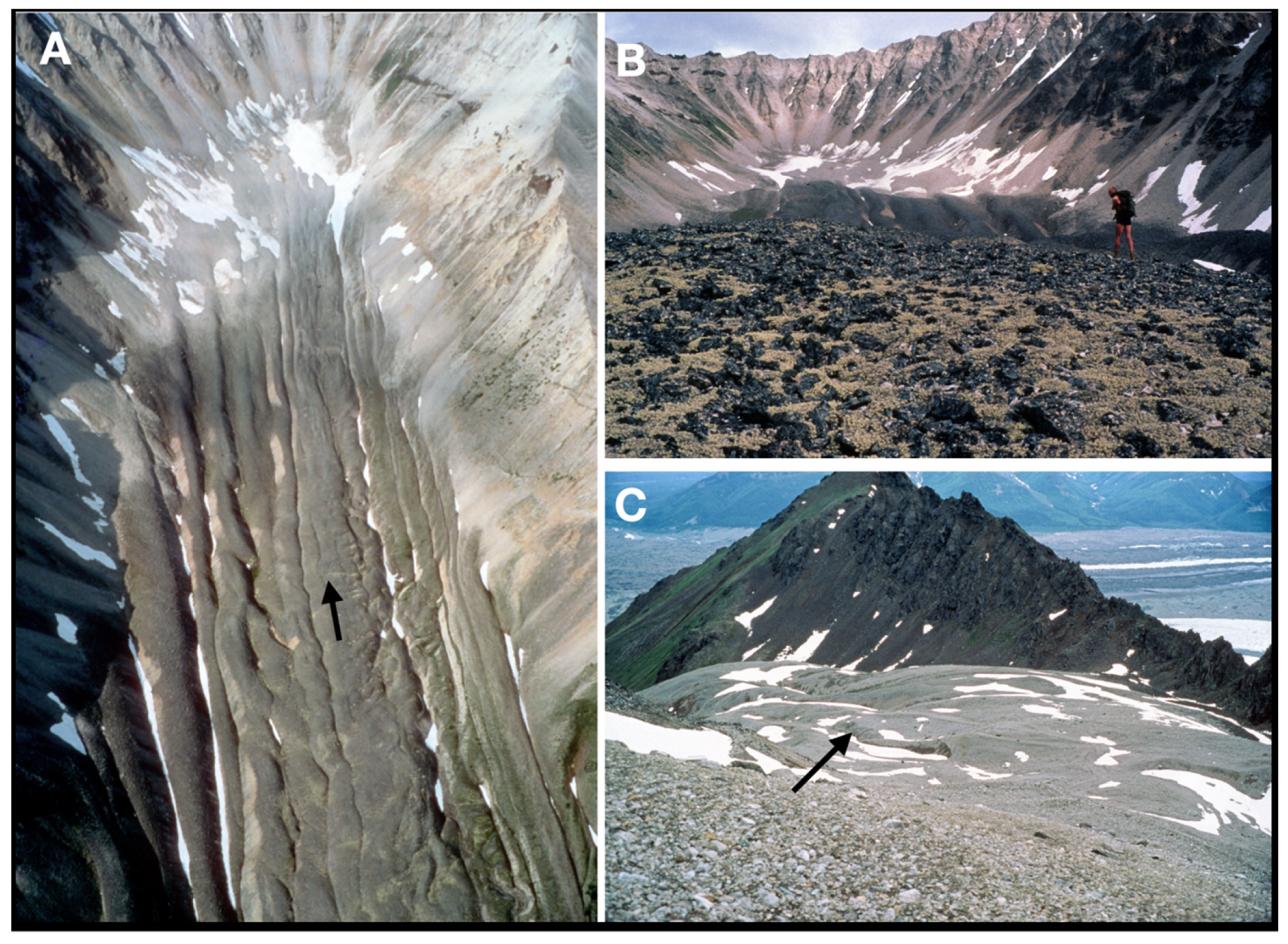
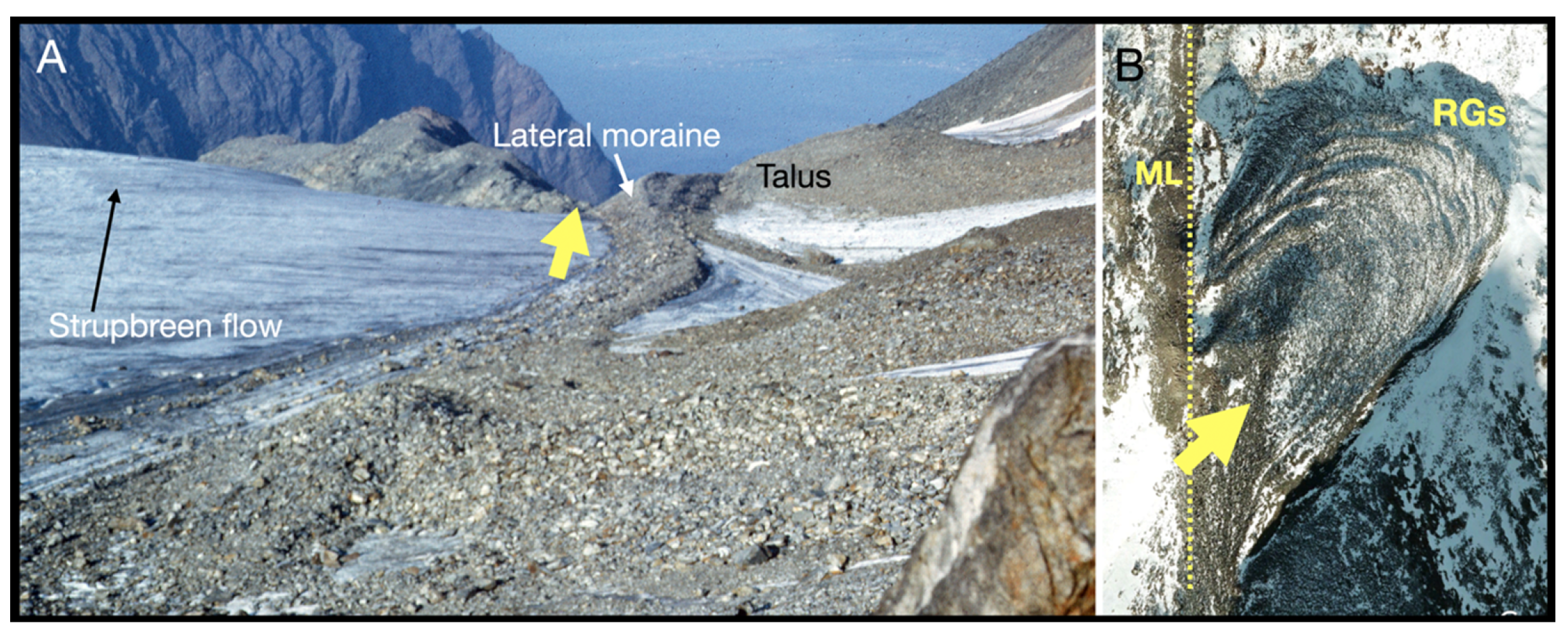
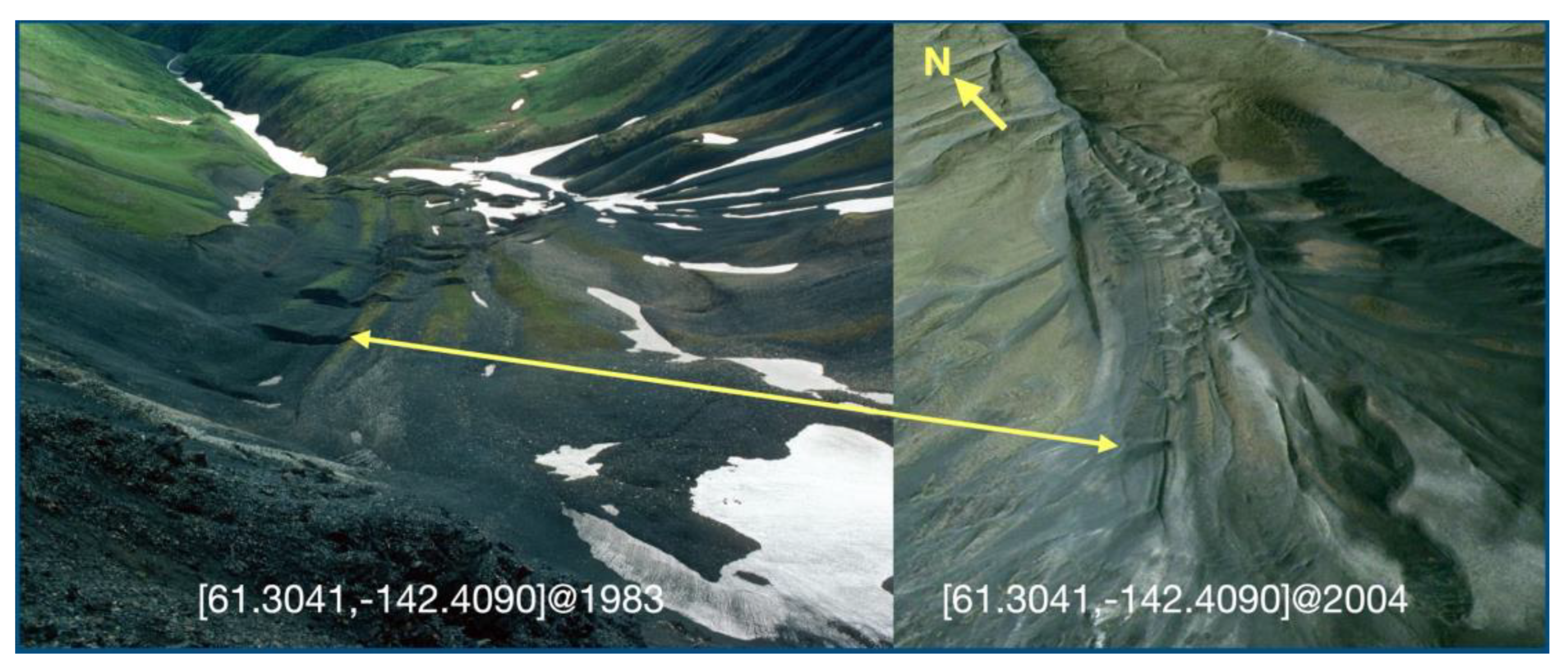

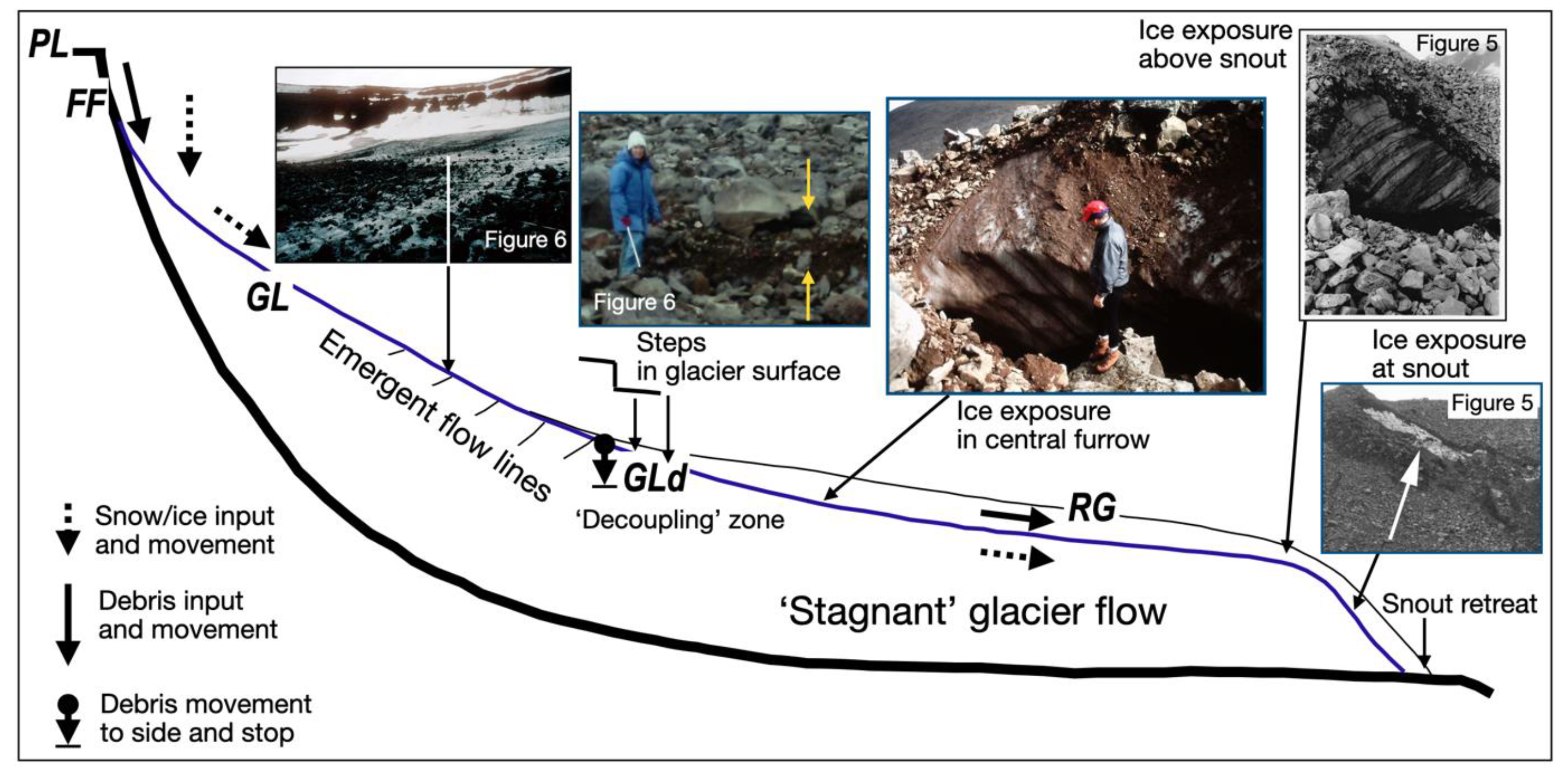
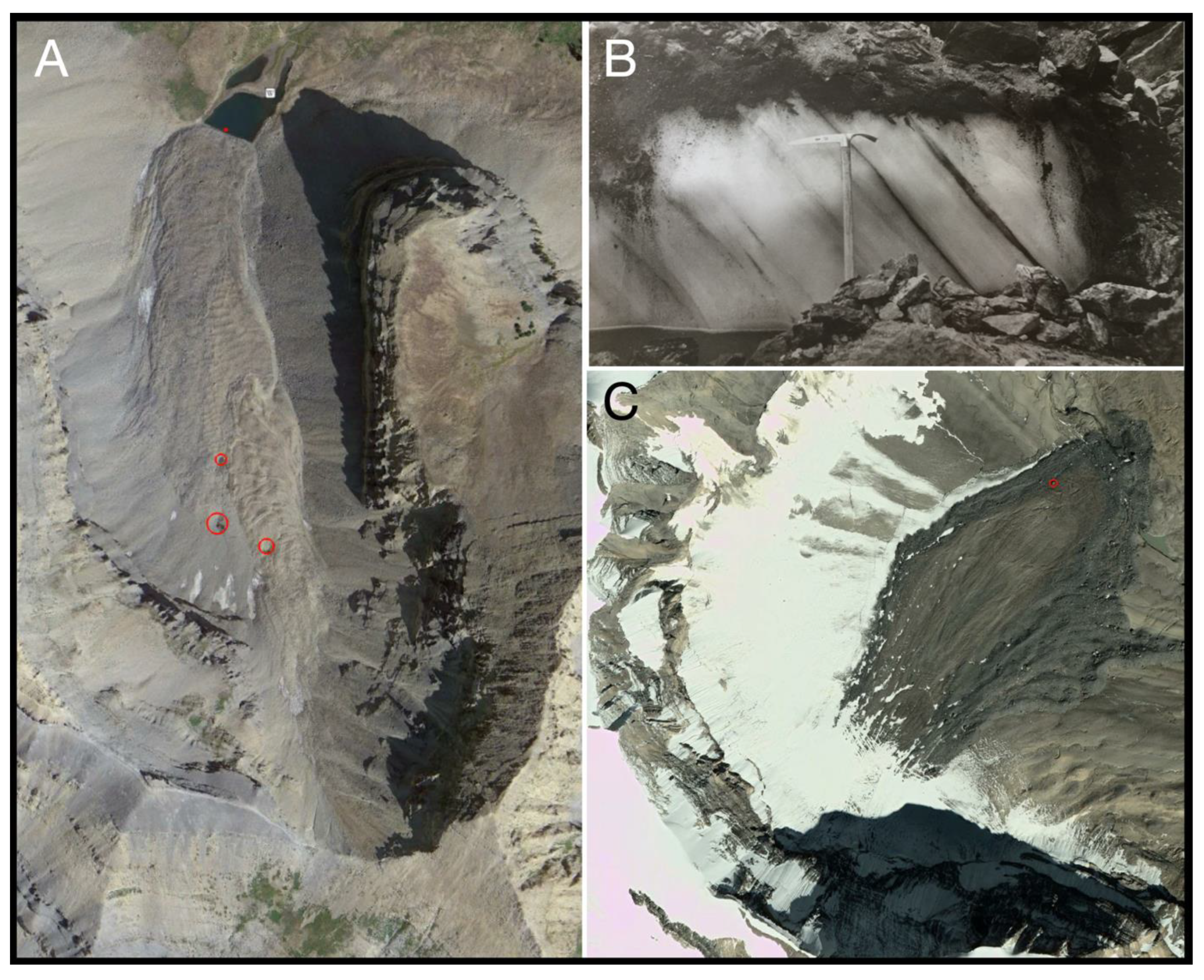
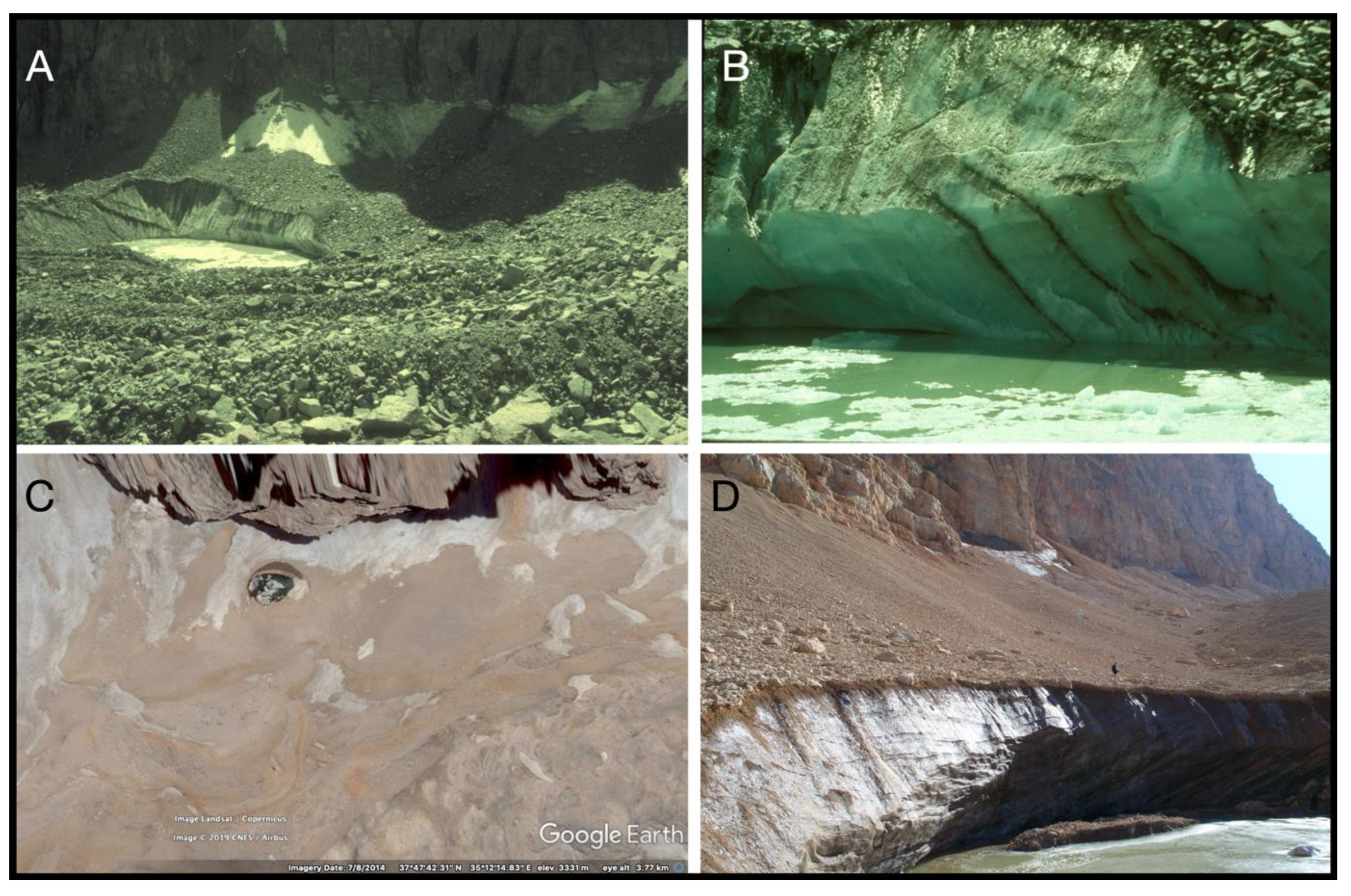
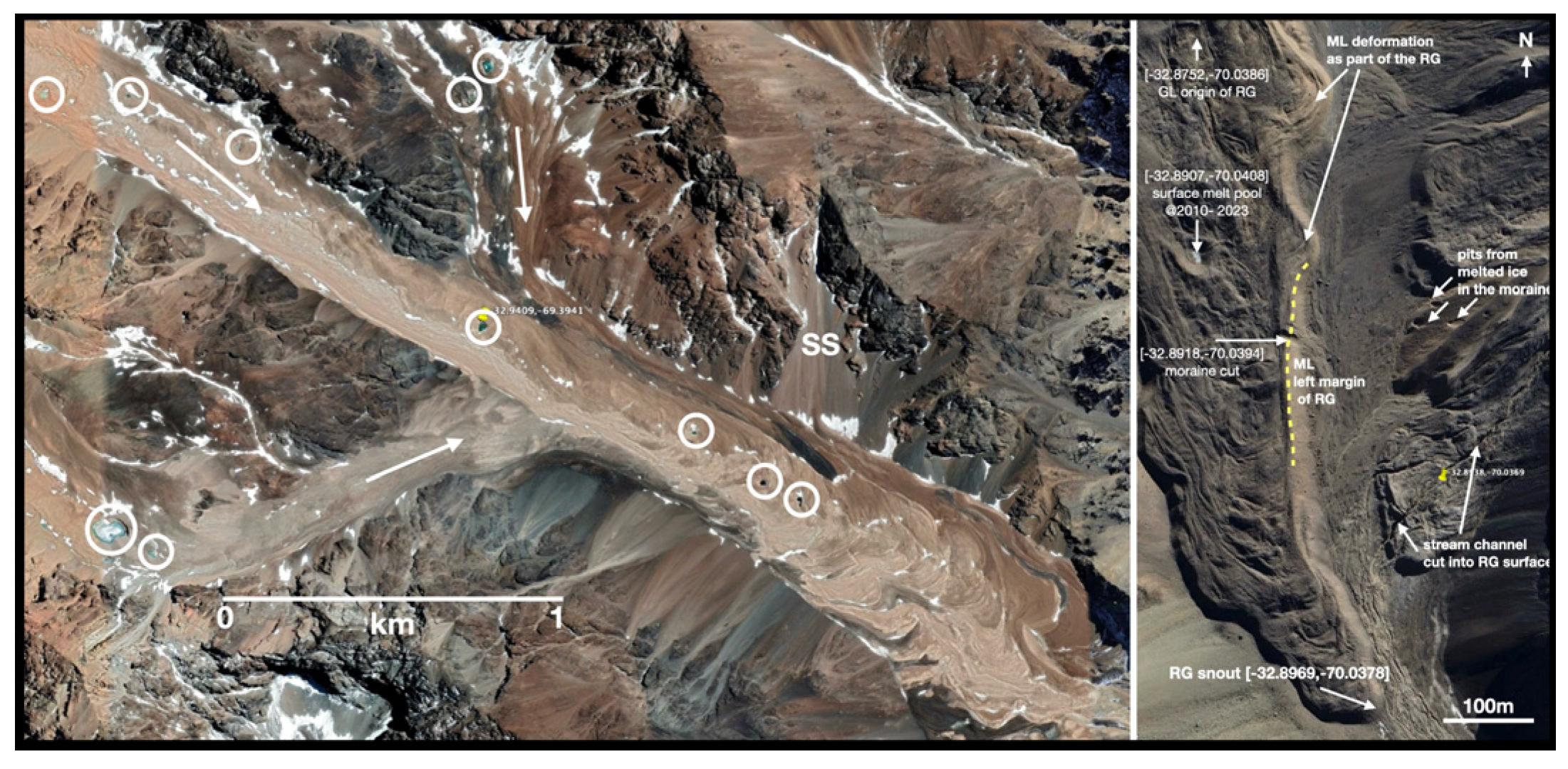
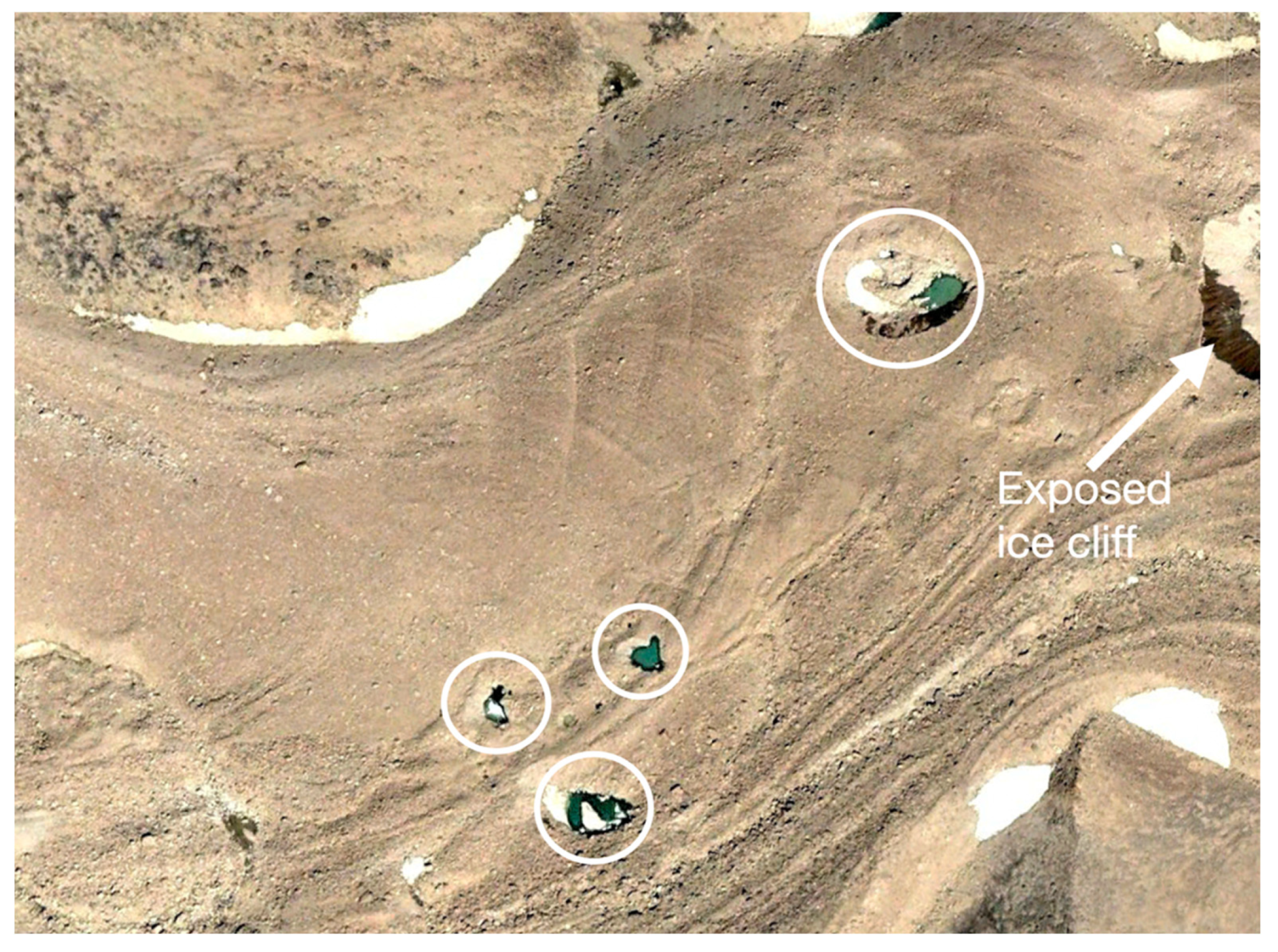
Disclaimer/Publisher’s Note: The statements, opinions and data contained in all publications are solely those of the individual author(s) and contributor(s) and not of MDPI and/or the editor(s). MDPI and/or the editor(s) disclaim responsibility for any injury to people or property resulting from any ideas, methods, instructions or products referred to in the content. |
© 2025 by the author. Licensee MDPI, Basel, Switzerland. This article is an open access article distributed under the terms and conditions of the Creative Commons Attribution (CC BY) license (https://creativecommons.org/licenses/by/4.0/).
Share and Cite
Whalley, B. The Identification and Diagnosis of ‘Hidden Ice’ in the Mountain Domain. Glacies 2025, 2, 8. https://doi.org/10.3390/glacies2030008
Whalley B. The Identification and Diagnosis of ‘Hidden Ice’ in the Mountain Domain. Glacies. 2025; 2(3):8. https://doi.org/10.3390/glacies2030008
Chicago/Turabian StyleWhalley, Brian. 2025. "The Identification and Diagnosis of ‘Hidden Ice’ in the Mountain Domain" Glacies 2, no. 3: 8. https://doi.org/10.3390/glacies2030008
APA StyleWhalley, B. (2025). The Identification and Diagnosis of ‘Hidden Ice’ in the Mountain Domain. Glacies, 2(3), 8. https://doi.org/10.3390/glacies2030008





